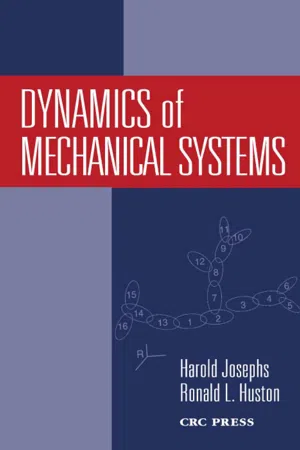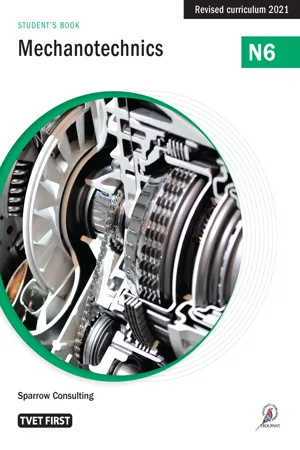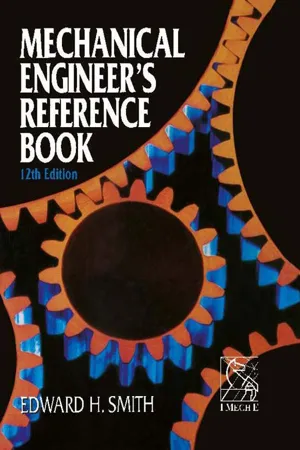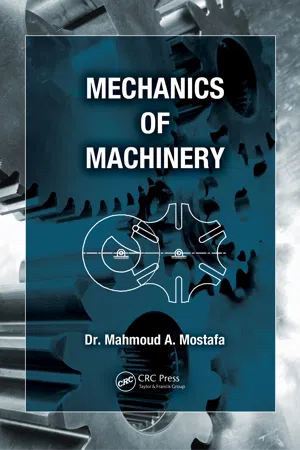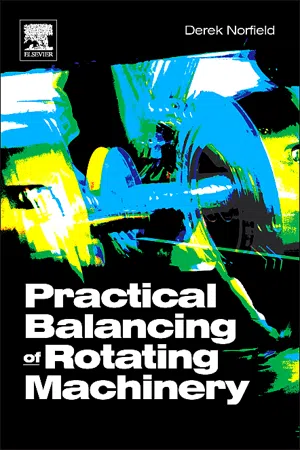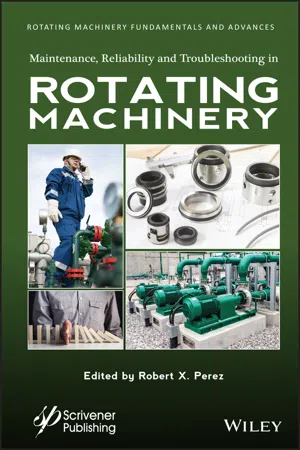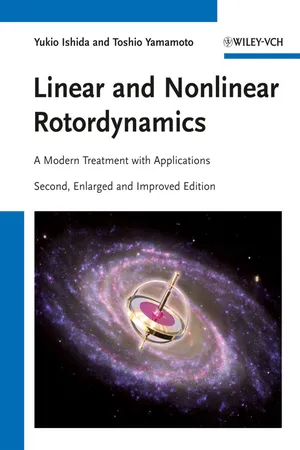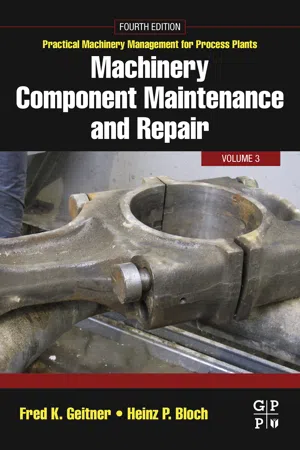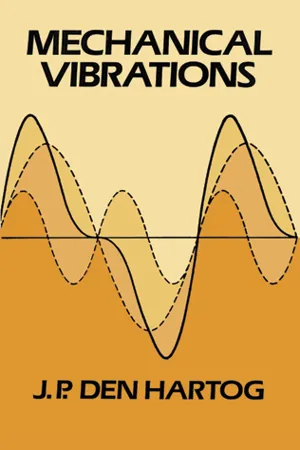Technology & Engineering
Balancing of Rotating Masses
Balancing of rotating masses refers to the process of ensuring that the center of mass of a rotating system coincides with its axis of rotation. This is important to prevent vibration, reduce wear and tear, and improve the overall performance and longevity of the system. Balancing can be achieved through various methods such as adding counterweights or adjusting the distribution of mass.
Written by Perlego with AI-assistance
Related key terms
1 of 5
11 Key excerpts on "Balancing of Rotating Masses"
- eBook - PDF
- Harold Josephs, Ronald Huston(Authors)
- 2002(Publication Date)
- CRC Press(Publisher)
513 15 Balancing 15.1 Introduction As with stability, balancing is a subject of great interest to engineers and to designers of mechanical systems — particularly in the design of rotating machinery. Unlike stability, however, balancing is a more applied subject, although balancing procedures can be rather detailed and technical. In what follows, we will discuss fundamental concepts of balancing. Readers interested in more detail or in more technical aspects should consult references at the end of the chapter or in an engineering library. In classical dynamical analyses of machines and mechanical systems, the machines or systems are generally modeled as ideal bodies with perfect geometry and uniform mass distribution — and, specifically, with no imbalance. In reality, of course, it is impossible to manufacture ideal bodies. Even with modern technologies, there will be variations in geometry and variations in mass distribution. Often, these variations are insignificant and unimportant. With high-speed and high-precision machines, however, even minor varia-tions in geometry and mass distribution can have significant and deleterious effects upon the function and life of a machine. This is especially the case with high-speed rotating bodies. A variation in geometry or in mass distribution away from the ideal is referred to as an imbalance . Because imbalances often lead to instability, particularly with rotating equipment, a technology of balancing has arisen which is intended to counter or eliminate the imbal-ances. Indeed, balancing technology has become an integral part of modern manufacturing processes for a wide variety of products ranging from rotors to propellers, automobile wheels, and bowling balls. In the following sections, we will briefly explore the funda-mentals of balancing and will restrict our attention to rotating bodies. Initially, we will study static balancing and then go on to dynamic balancing. - eBook - PDF
Mechanotechnics N6 Student's Book
TVET FIRST
- Sparrow Consulting(Author)
- 2021(Publication Date)
- Macmillan(Publisher)
Balancing is the process of restoring balance to a rotating element. Starter activity Discuss the following in class: 1. What causes a machine to vibrate excessively? 2. Why are small masses added to the outside or inside of vehicle’s wheel rims? 3. What is one of the main causes of the shortening of the life of a bearing? Figure 7.1: Rotor balancing on a dynamic balancing machine 175 Static and dynamic balancing TVET FIRST Unit 7.1: Balancing a single rotating mass 7.1.1 Introduction to balancing of rotating elements When a rotating element is in a state of unbalance, the centrifugal forces created by the unbalanced masses can adversely affect the bearings. They add unnecessary vibrations and shorten the life of machinery. bearing shaft light side heavy side flywheel centrifugal force heavy side centrifugal force light side axis of rotation of balanced assembly (shaft axis) axis of rotation of unbalanced assembly Figure 7.2: Out-of-balance flywheel In Figure 7.2, the centrifugal force of the heavy part of the assembly is larger than the centrifugal force of the light side of the flywheel. The result is that the entire assembly is pulled in the direction of the heavy side because the centre of gravity does not coincide with the axis of rotation. eccentricity (r) centre of rotation centre of gravity balance mass F C = m 1 ω 2 r 1 F C = mω 2 r centre of gravity (a) Unbalanced (b) Balanced due to addition of a mass Figure 7.3: Balancing the flywheel eccentricity: the distance of a mass to the centre of rotation (its radius) 176 Module 7 TVET FIRST Balancing is achieved by adding a mass at the light side or removing a mass at the heavy side. This will bring the centre of gravity in line with the axis of rotation (see Figure 7.3). Centripetal acceleration and centrifugal force Centripetal acceleration When a mass is rotating about a circle with a radius r and a constant velocity v, its direction changes all the time. - eBook - ePub
- Edward H. Smith(Author)
- 2013(Publication Date)
- Butterworth-Heinemann(Publisher)
4Figure 1.81.3.5 Balancing
In any rotational or reciprocating machine where accelerations are present, unbalanced forces can lead to high stresses and vibrations. The principle of balancing is such that by the addition of extra masses to the system the out-of-balance forces may be reduced or eliminated.1.3.6 Balancing of Rotating Masses
1.3.6.1 Single out-of-balance mass
One mass (m ) at a distance r from the centre of rotation and rotating at a constant angular velocity ω produces a force mω2 r. This can be balanced by a mass M placed diametrically opposite at a distance R , such that MR = mr1.3.6.2 Several out-of-balance masses in one transverse plane
If a number of masses (m1 , m2 , …) are at radii (r1 , r2 , …) and angles (θ1 θ2 , …) (see Figure 1.9 ) then the balancing mass M must be placed at a radius R such that MR is the vector sum of all the mr terms.Figure 1.91.3.6.3 Masses in different transverse planes
If the balancing mass in the case of a single out-of-balance mass were placed in a different plane then the centrifugal force would be balanced. This is known as static balancing . However, the moment of the balancing mass about the original plane would lead to what is known as dynamic unbalance .To overcome this, the vector sum of all the moments about the reference plane must also be zero. In general, this requires two masses placed in convenient planes (see Figure 1.10 ).Figure 1.101.3.6.4 Balancing of reciprocating masses in single-cylinder machines
The acceleration of a piston as shown in Figure 1.11 may be represented by the equation5Figure 1.11 * This equation forms an infinite series in which higher terms are small and they may be ignored for practical situations.where n = 1/r. If n - eBook - PDF
- Mahmoud A. Mostafa(Author)
- 2012(Publication Date)
- CRC Press(Publisher)
383 8 Balancing 8.1 INTRODUCTION In Chapter 7, we found that inertia forces are created in machines due to the masses and the acceleration of the members. These inertia forces in turn cause shaking forces in the machines. The shaking forces, in most machines, cause vibrations, which have harmful effects. In a close look at any mechanism, for instance, the engine mechanism, we see that it consists of a rotating member (the crank), floating member (the connecting rod), and a reciprocating member (the piston). Generally speaking, the inertia forces due to the rotating members can be completely elimi-nated by adding countermasses. Complete elimination of the inertia forces due to the floating and reciprocating parts requires expensive solutions. However, it is possible to reduce their effects by partial balancing, which is acceptable in most applications. 8.2 BALANCING OF ROTATING PARTS In many applications, the machines consist only from rotating parts, for example, turbine rotors, centrifugal pumps, transmission shafts with gears, and pulleys. These parts are manufactured by different processes, which apparently guarantee balanc-ing. However, under the most optimized circumstances, there is no guarantee that these parts are completely balanced due to the following reasons: 1. Blow holes in castings : It may be present within the material and cannot be detected by normal visual inspection. 2. Eccentricity : Exists whenever the geometric centerline of a part does not coincide with its rotating centerline. 3. Addition of keys and key ways : These are elements used to fix hubs on shafts. 4. Distortion : It may be the cause of stress relief in rotors fabricated by welding. Also, parts shaped by pressing, drawing, or extruding are liable to have distortion. Change of temperature causes thermal distortion. 5. Clearance tolerances : It is caused due to the accumulation of tolerances during the assembly. - eBook - PDF
- Derek Norfield(Author)
- 2011(Publication Date)
- Elsevier Science(Publisher)
2 Eliminate unwanted motion! Introduction When driving, or riding, in a car you want forward motion. That is the reason for being in the vehicle. You don’t want noise, vibra-tion, rattles, squeaks groans or screams. When operating machinery we usually want the rotational motion but not the side effects. Scream now. 48 Eliminate unwanted motion! How do we do that? It is all a matter of tolerances, tooling, unbalance correction methods and locations, balancing machines, and many other details that affect the performance of a product. Balancing may also be required due to the rotor design, or lack of design. Design errors, wide manufacturing tolerances, assembly procedures and rotor function, may cause large amounts of unbalance. Generally, the addition of a balancing operation allows for opening up manufacturing tolerances. Sometimes this is car-ried too far and the result is a higher amount of unbalance than what can be efficiently or even practically removed. The ‘value added’ by balancing comes from broadening of manufacturing tolerances and material specifications, elimina-tion of warranty failures, increased product performance, and the customer’s perception of a ‘quality’ product. Up to now, we have been looking at the results of not balancing to optimum levels. Now we turn to the process of balancing. Balancing is Science,Technology and Art Rotor balancing involves all three of the above parameters. Science – theory and calculations Technology – equipment and methods Art – the secrets to effective use of the science and technology Balancing is Science, Technology and Art 49 Don’t worry, its not that hard! That theory and calculation stuff can be scary! It is not com-plex but it is essential to a real comprehension of what we are doing in the balancing process. We will cover this in enough detail to give you a good understanding of the reasons why we balance to certain standards. Technology is the ‘nuts and bolts’ of what we are doing. - Robert X. Perez(Author)
- 2022(Publication Date)
- Wiley-Scrivener(Publisher)
Complex rotors typically have an infinite number of imbalances distributed randomly along its axis of rotation, which can only be assessed and corrected when the component is rotating. This kind of random imbalance distribution is referred to as dynamic unbalance. Dynamic unbalance in a rigid rotor requires balance correction in 2 planes. (A rotor that operates at a rotational speed below 70% of its critical speed is considered to be a rigid rotor. The critical speed is the speed at which the natural frequency of the rotor is excited. Ninety percent or more of industrial rotors are rigid.) Flexible rotors often required balance corrections at more than two planes.Balancing
Balancing is the process of adding or removing weight from the rotor to align the effective mass center with the axis of rotation. The ultimate goal of balancing is to add the proper correction weights, at the right locations, to offset the net imbalance on a troublesome rotor in order to minimize rotor shaking forces.Rotor unbalance generates forces that cause a rotor and support structure to vibrate at a frequency equal to running speed, commonly called the 1x frequency. Vibration associated with imbalance is the most common type of vibration found around industrial machines, which is why great time and effort is expended to balance rotors to accepted standards. In the case of a flexible rotor, we hope to ensure that vibration levels remain below an acceptable magnitude of rotor deflection at all speeds, up to the maximum service speed. Most rotors are balanced before machine assembly because of the limited access to the rotor in the field. Most balancing standards, such as ISO and API standards, classify rotor in accordance with their balancing requirements and establish methods of assessment of residual unbalance.When analyzed with a spectral analyzer, imbalance tends to show up as a predominant 1x peak in the vibration spectra. These high 1X amplitudes show up predominantly in the radial direction, i.e., normal to the axis of rotating. X-Y radial 1x components should be approximately equal. If the horizontal and vertical 1x vibration differ significantly in amplitude, consider the possibility of some type of looseness or a structural resonance.- eBook - PDF
- Agnieszka Muszynska(Author)
- 2005(Publication Date)
- CRC Press(Publisher)
CHAPTER 6 Selected Topics on Rotordynamics 6.1 INTRODUCTION TO BALANCING 6.1.1 Purpose of Balancing Rotor unbalance is the most common malfunction in rotating machinery. It is so widespread that, if any lateral vibration occurs in the rotor, there exists a tendency to associate it with unbalances. ‘‘Balancing the machine!’’ is usually the indication for the cure, very often executed with no investigation of what kind of vibrations the machine exhibits and what might have caused the malfunction. Quite frequently, balancing procedures performed on the machine, which actually suffers from another type of malfunction, worsens the situation, sometimes dramatically, especially when the malfunction is due to a rotor crack, as pointed out by Bently et al. (1986); see Section 6.5 of this Chapter and Section 7.2.8 of Chapter 7. Rotor vibrations due to unbalance have been recognized for over 100 years. Balancing procedures are equally old. However, during the last 25 years they have experienced substantial improvements due to implementation of vibration measuring electronic instruments and application of computers for data acquisition and processing. For over a century, researchers have published hundreds of papers on ‘‘how to balance machines’’. The volume of literature concerning rotor balancing is very large. Significant contributions to the field of balancing were made by Bishop, Parkinson, Kellenberger, Rieger, Tessarzik, Federn, Badgley, Goodman, Lund, Kramer, Darlow, Gunter, Jackson, Shiraki, Kanki, Eshleman, Bessonov, Gusarov, Kushul and many others. The book on balancing by Rieger (1986), gives a very comprehensive survey of classical methods of balancing. Various manufacturers of balancing equipment offer ready ‘‘recipes’’ for balancing. Recently, these ‘‘recipes’’ are often in a form of ‘‘black box’’ computer software. - eBook - ePub
Linear and Nonlinear Rotordynamics
A Modern Treatment with Applications
- Yukio Ishida, Toshio Yamamoto(Authors)
- 2013(Publication Date)
- Wiley-VCH(Publisher)
4.4 ). Instead, we must balance the rotor utilizing other experimentally measured data.In factories, rotors are balanced at the final stage of production. This is called factory balancing or production balancing. Factory balancing is performed using a balancing machine. Balancing machines are classified into static balancing machines that utilize gravitational force and dynamic balancing machines that utilize centrifugal force. Generally, balancing machines are used in order to balance rigid rotors.4.3.2.1 Static Balancing Machine
When a rotor is supported by ball bearings with little friction or placed on knife edges as shown in Figure 4.5 , the rotor stops when the eccentricity is located downward. Static balancing machine utilizes this phenomenon and this method is referred to as static balancing. As mentioned previously, the skew angle cannot be determined utilizing this method.Figure 4.5 Static balancing machine.4.3.2.2 Dynamic Balancing Machine
The balancing procedure which identifies unbalance by rotating the rotor is called dynamic balancing. In this dynamic balancing machine, the magnitude and angular position of the eccentricity can be simultaneously detected. Dynamic balancing machines are classified into two categories as shown in Figure 4.6 . One is the hard-bearing balancing machine in which the bearing support is hard. In this type of machine, its natural frequencies are higher than the rotor's operation range and forces (or accelerations) are detected at the bearings. The machine is rigid and, comparatively, can detect large unbalance. This type of balancing machine can be used for a wide range of mass distributions. The other is the soft-bearing balancing machine in which the bearings are supported softly. Most soft-bearing balancing machines detect vibrations (deflection or velocity). These machines are suitable for precise balancing of small machines, such as a small motor. Although they are called hard-bearing and soft-bearing - eBook - ePub
- Fred K. Geitner, Heinz P Bloch(Authors)
- 2019(Publication Date)
- Gulf Professional Publishing(Publisher)
component. Indexing: Incremental rotation of a rotor about its journal axis for the purpose of bringing it to a desired position. Mass centering: The process of determining the mass axis of a rotor and then machining journals, centers, or other reference surfaces to bring the axis of rotation defined by these surfaces into close proximity with the mass axis. Measuring plane (4.7): A plane perpendicular to the shaft axis in which the unbalance vector is determined. Method of correction (4.5): A procedure whereby the mass distribution of a rotor is adjusted to reduce unbalance or vibration due to unbalance to an acceptable value - eBook - PDF
- Clarence W. de Silva(Author)
- 2007(Publication Date)
- CRC Press(Publisher)
of rotation. The reasons for this eccentricity include the following: 1. Inaccurate production procedures (machining, casting, forging, assembly, etc.) 2. Wear and tear 3. Loading conditions (mechanical) 4. Environmental conditions (thermal loads and deformation) 5. Use of inhomogeneous and anisotropic material (which does not have a uniform density distribution) 6. Component failure 7. Addition of new components to a rotating device For a component of mass m ; eccentricity e ; and rotating at angular speed v ; the centrifugal force that is generated is me v 2 : Note the quadratic variation with v : This rotating force may be resolved into two orthogonal components, which will be sinusoidal with frequency v : It follows that harmonic forcing excitations are generated due to the unbalance, which can generate undesirable vibrations and associated problems. Problems caused by unbalance include wear and tear, malfunction and failure of components, poor quality of products, and undesirable noise. The problem becomes increasingly important given the present trend of developing high-speed machinery. It is estimated that the speed of operation of machinery has doubled during the past 50 years. This means that the level of unbalance forces may have quadrupled during the same period, causing more serious vibration problems. An unbalanced rotating component may be balanced by adding or removing material to or from the component. We need to know both the magnitude and location of the balancing masses to be added to, or removed. The present section will address the problem of component balancing for vibration suppression. Note that the goal to remove the source of vibration (namely, the mass eccentricity) typically by adding one or more balancing mass elements. Two methods are available: 1. Static (single-plane) balancing 2. - eBook - ePub
- J. P. Den Hartog(Author)
- 2013(Publication Date)
- Dover Publications(Publisher)
dynamically unbalanced, because this type of unbalance can be detected by a dynamic test only, while on a static balancing machine the rotor appears to be perfect.FIG. 6.8. A dynamically unbalanced rotor causes equal and opposite rotating reactions on its bearings.We shall now prove that any unbalance whatever in a rigid rotor (static, dynamic, or combined) can be corrected by placing appropriate correction weights in two planes, the end planes I and II of the rotor usually being chosen on account of their easy accessibility (Fig.6.9 ). Let the existing unbalance mr consist of 4 in. oz. at one-quarter of the length of the rotor and of 3 in. oz. in the middle between the planes I and II but turned 90 deg. with respect to the first unbalance. In determining the corrective masses to be placed in the planes I and II, we shall first find the corrections for the 4-unit unbalance, then find them for the 3-unit unbalance, and finally add the individual corrections together. The 4-unit unbalance will cause a 4-unit rotating centrifugal force, which can be held in static equilibrium by a 3-unit force at I and by a one-unit force at II. Thus we have to place a 3-unit correction mass in plane I, 180 deg. away from the original unbalance, and similarly a single-unit correction mass in plane II, also 180 deg. away from the original unbalance.FIG. 6.9. The most general unbalance in a rigid rotor can be corrected by placing one weight in each of two planes I and II.The 3-unit unbalance is corrected by 1½-unit masses in each of the two planes. Thus in total we have to place in plane I a 3-unit mass and a 1½-unit mass, 90 deg apart. The two centrifugal forces due to these can be added together by the parallelogram of forces so that instead of placing two correction masses in plane I we insert a single mass of units at an angle α = tan−1 0.5 from the diameter of the 4-unit unbalance. Similarly, the total correction in plane II consists of a correction mass of units at an angle β = tan−1
Index pages curate the most relevant extracts from our library of academic textbooks. They’ve been created using an in-house natural language model (NLM), each adding context and meaning to key research topics.
